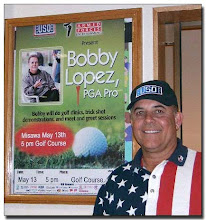The question may seem too simple. Alignment deals with the shoulders, hips, knees and feet. We want these four body parts all in “alignment” so they are all pointing in the same direction. Pointing them in the same direction is “aiming.” A person can have good alignment and not be aimed at the target. Also, because of wind factor or slope angle, you may need to aim somewhere other than the flag or the green.
Most amateurs don’t recognize the full effect of alignment and aim. Proper alignment is absolutely essential to a proper swing. Some swing faults can be attributed to poor alignment.
In many ways, aim is just as critical. Aim deals with a perception. Therefore, you judge your ball flight by where you perceive you are aimed. If your aim is off target, you will adjust your swing for what you think is a swing flaw, when it is actually an aiming mistake.
Aim and alignment are also a lot more difficult than most players realize. The task is subject to misperceptions caused by several factors:
(a) The target is 90 degrees from the direction your body faces. This means you must be able to set both the club face and your body in a line perpendicular with the target line. It sounds easier than it is; most players are completely unaware when their line is off. Players will often begin the day with good aim and alignment and then unwittingly slip into misdirection as the round progresses...or in this case, regresses.
(b) When you are addressing the ball, looking down the target line, it may appear that the desired hitting direction has changed slightly.
(c) Sometimes you must hit from a slope, forcing you to adjust aim, alignment and setup.
(d) The terrain and obstacles in your target path affect your perception of target direction.
(e) It’s easy to forget how important it is to properly aim. Without a diligent and consistent pre-shot routine, you will tend to become less aware of the steps you are taking to aim. This is a big mistake.
It takes practice to manage each situation presented by the golf course. Golfers are highly susceptible to faults even in situations with no added challenges. Poor aim and alignment skills cause poor play for many golfers.
One of the most common errors is setting up too far right of the target. This may seem incompatible with the fact that most players tend to be slicers. Wouldn’t lining up to the right send their ball even further from the target? Not necessarily. When the setup is
to the right, a player tends to swing across the ball, on an outside in swing path. This outside-in path will help start the ball on a path toward the target, which is left of the player’s aim.
Usually though, the player strikes the ball with an open club face angle, and the resulting spin forces the ball back to the right. Players will then compensate for this tendency by cupping the hand at just the right moment in the follow-through and releasing the left
arm toward the target. It is extraordinarily difficult to time this movement consistently. Too many angles, too many variables come into play. It all adds up to an unpredictable, un-repeatable swing, much of which could have been avoided with a proper setup.
The Steps to Proper Aim and Alignment.
1. Set the Club face. You must first set the club face perpendicular to the target. Don’t make the mistake of setting your feet first. Instead, carefully choose the target line, set the club face angle, and then align your body to the club face.
How do you select and mentally hold the target line? It is very helpful to choose a target along the ground-line leading to the ultimate landing area. Pick a point a few yards ahead and aim the club at it. The more you can envision this line, the better. You might imagine a strip of neon yellow tape stretching from your ball to the chosen point.
2. Align Your Body in Relation to the Club. Place your feet along an imaginary line parallel to the target line. When you set your feet, your hips should naturally fall in line. Continue this alignment so the entire body is aligned and aimed parallel to the target line. Imagine a set of train tracks to the target, with your ball on one track and your body aligned on the other.
3. Align Your Eyes. The eyes play a critical role at this point. They deliver directional information to your brain, which then sends the message to your muscles. Garbage in... You know what comes next. Your eyes may give you a different message about direction once you are in the hitting position. You must trust that your club face and body are properly aligned. The more you practice your setup, the more confidence you will have that you are aimed correctly.
When you are looking at the ball, you should have the feeling that your eyes are parallel to the target. In other words, a line running through your right eye and into the left should be parallel to the target line. This will require you to keep your head relatively level. You will most likely find yourself tilting your head so that your right ear is below the left. Try to avoid this, because it can skew your directional perception. When you turn your chin on this forward angle, it tends to pull your vision to the right of the target. Even if everything else is aligned, this misalignment can cause undesirable swing compensations.
Once you are in hitting position, look at the target again, visualizing the desired direction of the ball. Instead of lifting your head to look down the target line, swivel it. You only need to rotate it enough to view the selected ground-line target a few yards ahead.

